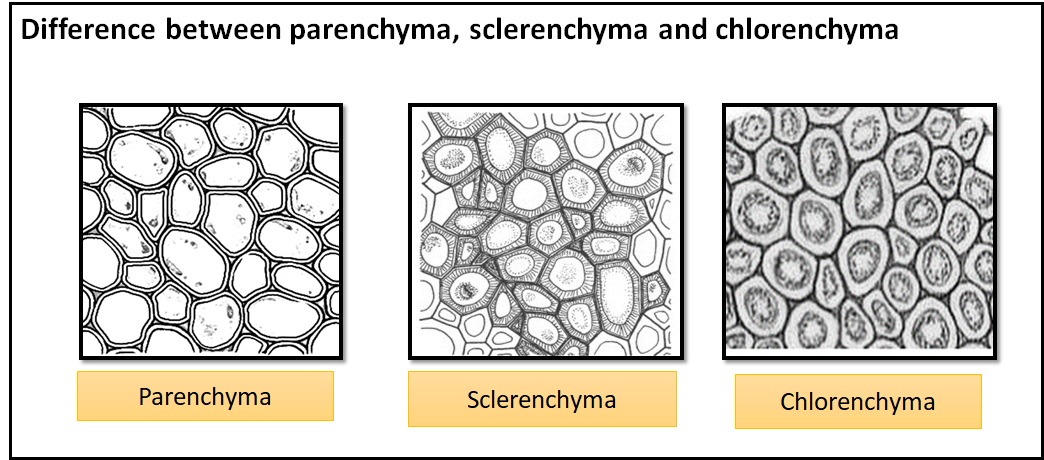
Differentiate between parenchyma, collenchyma, and sclerenchyma based on their cell wall.
Answer
485.1k+ views
Hint: These cells newly formed and become structurally and functionally specialized. They lose the ability to divide and are called permanent or mature cells, and the tissues formed from these cells are known as permanent tissues.
Complete step-by-step answer:
Classification of permanent tissues:
Permanent tissues are basically of two types, simple permanent and complex permanent.
Simple permanent tissues: It is made up of only one type of cell. Simple tissues found in plants are:
-Parenchyma
-Collenchyma
-Sclerenchyma

Note: Special type of parenchyma found in hydrophytes are called Aerenchyma i.e. plants living in water bodies.
Types of cells in sclerenchyma are: -
Sclerenchyma fibers: Highly elongated cells with pointed ends, these provide mechanical strength.
Sclereids: These are spherical, oval, or cylindrical cells. They occur in soft parts that are the pulp of fruits.
Complete step-by-step answer:
Classification of permanent tissues:
Permanent tissues are basically of two types, simple permanent and complex permanent.
Simple permanent tissues: It is made up of only one type of cell. Simple tissues found in plants are:
-Parenchyma
-Collenchyma
-Sclerenchyma

| Parenchyma | Collenchyma | Sclerenchyma |
| Parenchymatous cells are the living cells and are generally isodiametric (nearly equal diameters). These cells may be spherical, oval, round, polygonal, or elongated in shape. | It is an elastic, living, mechanical tissue which may be oval, spherical, or polygonal in shape. | Sclerenchyma is a Greek word meaning hard tissue, they are usually dead without protoplast. Cells are elongated and narrow. |
| They are thinly walled. Their cell walls are made up of cellulose. These cells may either be closely packed with no or small intercellular space. | At the corner of the cells, thickening of the cellulose, hemicellulose, and pectin develop due to which the cell wall becomes thick at the corners. These cells are closely packed with each other without intercellular spaces. | These have a highly thickened cell wall. Their wall consists of cellulose, hemicellulose, and specialized organic material lignin which provides mechanical strength to the plant and its parts. |
| Various functions are the storage of food, photosynthesis, and secretions of substances like renin, nectar, oil, etc. | The functions of collenchyma are to provide mechanical support to the growing parts of the plants such as young stems and take part in photosynthesis. | Functions are providing Mechanical strength. These are also present in fruit walls of nuts like walnut and almond, and seed coats of legumes. |
Note: Special type of parenchyma found in hydrophytes are called Aerenchyma i.e. plants living in water bodies.
Types of cells in sclerenchyma are: -
Sclerenchyma fibers: Highly elongated cells with pointed ends, these provide mechanical strength.
Sclereids: These are spherical, oval, or cylindrical cells. They occur in soft parts that are the pulp of fruits.
Recently Updated Pages
Glucose when reduced with HI and red Phosphorus gives class 11 chemistry CBSE

The highest possible oxidation states of Uranium and class 11 chemistry CBSE

Find the value of x if the mode of the following data class 11 maths CBSE

Which of the following can be used in the Friedel Crafts class 11 chemistry CBSE

A sphere of mass 40 kg is attracted by a second sphere class 11 physics CBSE

Statement I Reactivity of aluminium decreases when class 11 chemistry CBSE

Trending doubts
10 examples of friction in our daily life

Difference Between Prokaryotic Cells and Eukaryotic Cells

One Metric ton is equal to kg A 10000 B 1000 C 100 class 11 physics CBSE

State and prove Bernoullis theorem class 11 physics CBSE

What organs are located on the left side of your body class 11 biology CBSE

Define least count of vernier callipers How do you class 11 physics CBSE




